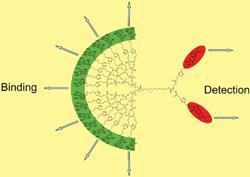New dendrimers that display both recognition and detection properties with enhanced biological activity have been developed.
New dendrimers that display both recognition and detection properties with enhanced biological activity have been developed by US researchers.
Dendritic molecules are ideal candidates for targeted drug delivery systems - they have numerous chain ends that can act as multivalent binding sites and interact with biological receptors, says Craig Hawker at the University of California, Santa Barbara.
Hawker and colleagues synthesised a series of dual-purpose dendrimers that can recognise and detect and, as a result of their unique structure, show enhanced biological activity.

The macromolecules have an unsymmetrical dendritic structure and the chain ends are composed of either sugar molecules or chromophore units. The bifunctional dendrimer is prepared using click chemistry, meaning highly efficient and reliable chemical reactions are used, and the step-wise synthesis enables the molecular architecture to be controlled.
The largest dendritic structure in the family has sixteen end groups composed of sugar units, or recognition sites, and two chromophore units that act as fluorescent labels or detection agents. Hawker and colleagues tested the performance of the dendrimer in a binding assay and found that it has significantly enhanced activity compared to that of the monomeric sugar.
In the future, with the development of new synthetic techniques, the researchers predict that more complex structures which approach the size of viral capsules could be made. The ability to prepare multi-functional materials ’with controlled numbers of binding ligands, detection elements and therapeutic agents would be a major advance in the diagnosis and treatment of disease,’ said Hawker.
Alison Stoddart
References
P Wu, M Malkoch, J N Hunt, R Vestberg, E Kaltgrad, M G Finn, V V Fokin, K B Sharpless and C J Hawker, Chem. Commun., 2005, 5775 (DOI: 10.1039/<MAN>b512021g</MAN>)






No comments yet